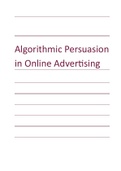Essay
Grade A EPQ on ‘How Coca-Cola uses design to appeal to consumers’
- Module
- Dissertation
- Institution
- AQA
This is a high quality, EPQ dissertation responding to the question ‘How does Coca-Cola use design to appeal to consumers?’, awarded a grade A.
[Show more]












